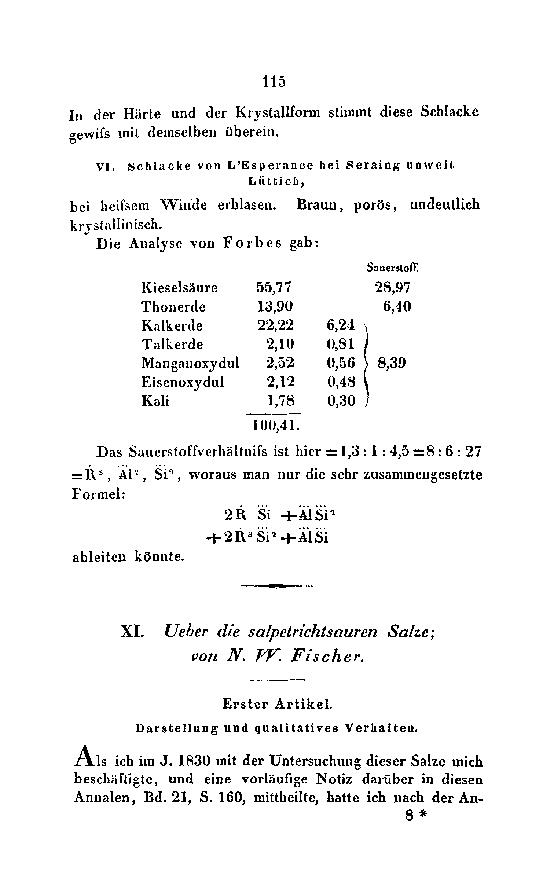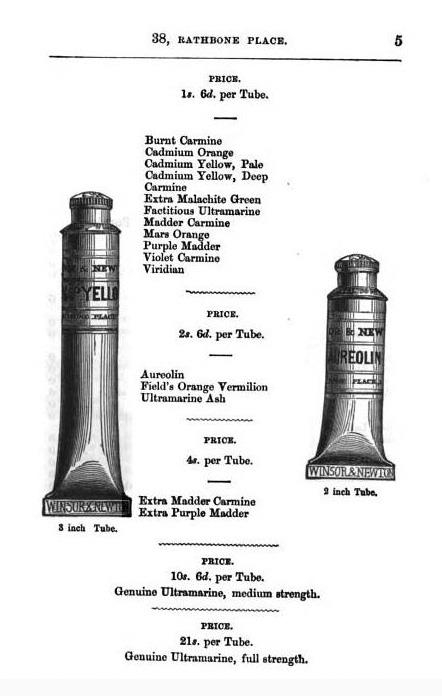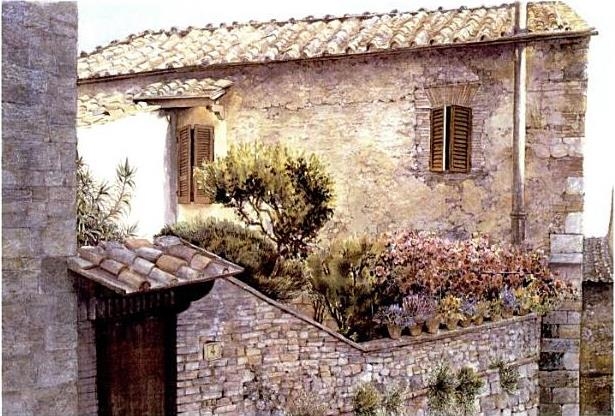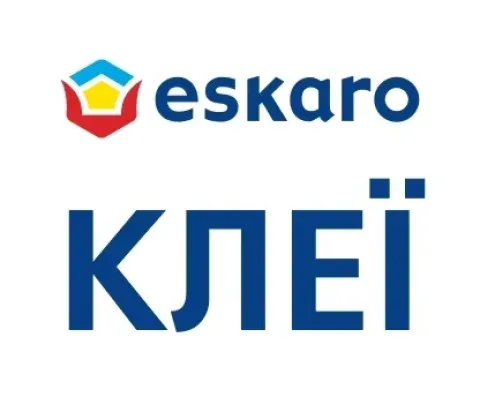
CHEMISTRY AND PAINTING
COBALT PIGMENTS
The honor of discovering cobalt as an individual chemical element belongs to the famous Swedish chemist and mineralogist Georg Brandt. In 1735, while working with samples of Saxon ore in Stockholm in the laboratory of the Royal Mint, of which he was the head, he managed to obtain a small ball of a gray, previously unknown metal - cobalt. In his diary, Brandt later wrote: "I had the good fortune to be the discoverer of a new semimetal, called cobalt regulus." The word "semimetals" should not alarm us, since by this concept Brandt understood metal-like substances that, unlike the six metals of antiquity (gold, silver, copper, iron, tin, lead), could not be forged.
As for cobalt minerals, they gained popularity much earlier, back in ancient times. They were used to dye glass blue several millennia BC. In the excavations of ancient Babylon, Persia and Egypt, artificial glass ornaments of a rich blue color were found, which included from 0.05 to 0.15% cobalt (Fig. 1). Blue glasses painted with this metal were found in the cultural monuments of the Roman Empire, and blue cobalt mosaics were found in the ruins of Pompeii. In ancient China, the ability of metal compounds to impart color to glass was also appreciated. For 200 years BC. e. Chinese craftsmen made blue glass beads. Blue cobalt glasses decorate the stained glass windows of the Reims and Amiens cathedrals, the Kiev St. Sophia Cathedral, mosaics in the mausoleums of Samarkand. Since the 13th century. cobalt minerals began to be used for coloring porcelain in China, and from the beginning of the 18th century. - in France and Germany for the production of the famous Sèvres and Meissen porcelain (Fig. 2.1 and 2.2).
The end of the 17th and beginning of the 18th centuries significantly determined the unique place that cobalt compounds managed to occupy in painting. Thanks to the synthesis in 1802 of the thenar blue (CoO×Al2O3), the problem of blue color in artistic paints was solved. A little earlier, in 1780, the Swedish chemist Sven Riemann, while heating a mixture of a large excess of zinc carbonate with a small amount of cobalt carbonate (II), was able to obtain a green pigment, later called cobalt or Riemann.
During heating, zinc and cobalt carbonates decompose, forming the corresponding oxides:
ZnCO3 = ZnO + CO2,
CoCO3 = CoO + CO2.
Then cobalt (II) oxide dissolves in zinc oxide, forming a solid solution of malachite color. The general formula of cobalt green pigment can be designated as CoO×xZnO (Fig. 3). The color of the pigment varies depending on the content of cobalt oxide. The composition of the commercial dark green pigment can be described by the approximate formula CoO×15ZnO. Light green samples contain much less cobalt, their approximate formula is CoO×50ZnO.
Riemann green came on sale only in 1835, but it began to be used more or less widely only from 1860, when zinc whites became available (zinc oxide is one of the components for the production of green). The translucent, bright pigment, which has a bluish-green hue, is distinguished by high chemical resistance, like most pigments obtained at high temperature. One of the first researchers of the chemical component of fine art, professor of chemistry at the Royal Academy of Arts in London, Arthur Herbert Church, in his book "The Chemistry of Paints and Painting", published in 1890, speaks of this pigment as follows: "Cobalt green, in fact, is one of those rare pigments that are both chemically and artistically perfect."
Unfortunately, Riemann green could not withstand competition with chromium oxide and green phthalocyanine pigments. Today it is a rare paint on the palette of artists. However, this pigment has the opportunity to begin a second life in a rather unusual role, associated not with painting at all, but with the world of innovative developments and new technologies. At the University of Washington (Seattle, USA), scientists have found that this pigment has unique magnetic properties that allow it to be used in spintronics - a branch of physics that studies the transfer of electric current using the spin of electrons in solids. The achievements of spintronics are used to store and process computer information. Perhaps in the near future, cobalt green will make it possible to create devices that, at room temperature, will operate much faster and require much less energy than conventional semiconductor electronics (Fig. 4.1).

In 1848, the range of cobalt pigments was supplemented by a complex compound where the metal exhibits an oxidation state of +3, namely potassium hexanitrocobaltate (III) K3[Co(NO2)6]. This compound was first synthesized by N.V. Fischer, a chemist from Breslau (now Poland), who published his article in one of the prestigious scientific journals of the time – “Annals of Chemistry and Physics”. The first page of the author’s scientific publication is shown in Figure 4.1. The bright yellow crystals of the substance attracted the attention not only of chemists, who began to use it as a reagent for the qualitative detection of cobalt (Fischer’s salt), but also of artists, who quickly appreciated the beautiful and pure tone of the pigment, which acquired the trade name “aureolin” (Figure 4.2). Just four years after its discovery, aureolin was already being used by painters, who certainly noticed its vivid, bright color and its high lightfastness. Aureolin was included in the catalogs of artists' paint sellers (Figure 4.3). Pigment manufacturers obtained it by precipitation reactions from aqueous solutions, for example:
CoCl2 + 7KNO2 + 2CH3COOH = K3[Co(NO2)6]¯ + 2NaCl + 2Na(CH3COO) + NO + H2O.

Another cobalt pigment, this time sky blue, was synthesized by Hepfner in 1821. However, for almost forty years the pigment was forgotten, until in London in 1860 George Rowney, the successor to the family business of producing artistic paints, gave it a second life, including it in the range of his company under the name "ceruleum". The word "ceruleum" was known since the times of the Roman Empire and meant blue paint in general. The Latin name of the pigment comes from the word caelum - sky. A. Church gives the following composition of the pigment: 49.7% tin oxide (IV); 18.6% cobalt oxide (II) and 31.7% silicon oxide (Fig. 5).
The technology for obtaining ceruleum is quite complex. First, transparent pink crystals of Co[Sn(OH)6]×3H2O are precipitated during the interaction of sodium hexahydroxostannate (IV) with a soluble cobalt salt:
Na2[Sn(OH)6] + CoCl2 + 3H2O = 2NaCl + Co[Sn(OH)6]×3H2O¯.
To prevent hydrolysis, the synthesis is carried out in a concentrated ammonia solution. Then the precipitate is calcined and cobalt orthostannate of the general formula 2CoO×SnO2 is obtained, which is the basis of the pigment. Cobalt orthostannate can also be obtained by calcining freshly precipitated stannic acids (SnO2×nH2O) and cobalt nitrate (II) (Co(NO3)2) in the presence of a flux - potassium chloride.
Ceruleum is widely represented on the palette of artists due to its pure color, high light resistance and chemical stability. Its important advantage is the absence of a purple tint under artificial lighting. The bright, beautiful pigment was especially loved by the Impressionists. In his painting “Gare Saint-Lazare” (1877) (Fig. 5.2), now kept in the Musée d’Orsay in Paris, Claude Monet even used cerulean to paint a cloudy sky.
Often, to obtain a purple tint, artists have to mix blue and red, not always obtaining the desired shade. The situation changed significantly with the discovery in 1859 by the French chemist and pigment specialist Louis Alphonse Salvet of purple cobalt. The scientist published an article in the Proceedings of the French Academy of Sciences entitled “Mineral Pigments of Green and Purple Color,” in which he described the technology for obtaining the pigment. This technology is used virtually unchanged today. First, the aqueous solutions of cobalt sulfate and sodium hydrogen orthophosphate are combined:
3CoSO4 + 4Na2HPO4 + 8H2O → Co3(PO4)2×8H2O¯ + 2NaH2PO4 + 3Na2SO4.
The resulting precipitate is calcined to remove water of crystallization:
Co3(PO4)2×8H2O → Co3(PO4)2 + 8H2O.

Somewhat later, another cobalt violet pigment was discovered - cobalt (II) ammonium orthophosphate monohydrate CoNH4PO4×H2O, which was called "light violet cobalt".
Pigments based on cobalt phosphates are distinguished by high light resistance and chemical stability. They can be used in both oil and water paints, but their cost is relatively high. Nevertheless, they are valued by artists for their ability to convey the most subtle shades of violet. Cobalt violet was one of the seven colors used by one of the geniuses of impressionism, Camille Pissarro. In his huge canvases “Water Lilies” (201×427 cm) (Fig. 6.1) and “Irises” (201×150 cm), now kept in the National Gallery in London, Claude Monet conveyed the natural beauty of flowers with the help of cobalt phosphates. Modern artists use cobalt purple in their works. The English landscape painter Frances Shearing in her painting “House in San Gimignano” widely used this pigment to convey the shades of Tuscan stone (Fig. 6.2).
Due to its ability to form intensely colored stable compounds, cobalt has acquired an absolutely unique significance in painting. The synthesis of new inorganic compounds based on this metal in the 19th century. not only enriched our knowledge in the field of inorganic chemistry, but also gave artists the opportunity for self-realization. Mara Shalaida, a researcher of the history of painting, notes: “Chemists and paint manufacturers began to work hand in hand to obtain new formulas for the production of pigments. For the first time, completely synthetic pigments were obtained. The discovery of previously unknown minerals gave access to a whole range of luxurious and stable pigments, the likes of which had never been known before.” Published in 1835 by the English colorist George Field, a book entitled “Chromatography, or a Treatise on Color and Pigments and their Power in Painting,” which was a textbook for many artists of its time, contained mention of only one cobalt-based pigment – cobalt blue, and was only 276 pages long. The treatise, completely rewritten after the author's death by Thomas Salter and published in 1869, has almost doubled in size, it already describes in detail ceruleum, Riemann green, cobalt violet, as well as pigments based on other metals, first obtained in a short period of time of several decades.
Today in the world of digital photography, when obtaining an image and transmitting it to any part of the globe is not the slightest hassle, when drawing is perceived as a hobby, it is difficult for us to imagine that until quite recently the only opportunity to preserve the memory of the past was painting. It was a serious craft, strangely connected with chemistry and chemical technology. The discoveries that artists made in their workshops, trying to obtain new colors and new materials, influenced the history of mankind, and some of them entered our everyday lives.
Authors: Khaletskyi V. A. 1, Khaletskaya K. V. 2, Vasilevska E. I
Literature. 1. Volkov, V.A. Prominent chemists of the world: Bibliographic reference / V.A. Volkov, E.V. Vonsky, G.I. Kuznetsova; under the editorship of V.I.Kuznetsov. - M.: Higher School, 1991. - 656 p. 2. Kazakov, B.I. Cobalt / B.I. Kazakov // Popular library of chemical elements: in 2 books. - open ed. I.V.Petryanov-Sokolov. - ed. 3rd, ex. and additional – Book 1: hydrogen – palladium. - M.: Nauka, 1983. - 576 p. 3. Perelman, F.M. Cobalt and nickel / F.M. Perelman, A.Ya. Zvorykin - M.: Nauka, 1975. - 215 p. 4. Spotlight on Color: Cobalt Green [Electronic resource] / Winsor & Newton. Resource center. – Mode of access: https://www.winsornewton.com/resource-centre/product-articles/spotlight-on-colour-cobalt-green/. - Date of access: 03.01.2012. 5. Ball, P. Bright Earth: The Invention of Color / P. Ball. - Chicago: University of Chicago Press, 2001. - 384 p. 6. Belenkyi, E.F. Chemistry and technology of pigments / E.F.Belenky, I.V.Riskin; 3rd ed. ex. and additional - Leninigrad: Goshimizdat, 1960. - 757 p. 7. Salter, T.W. Field's Chromatography; or treatise on colors and pigments as used by artists / T.W.Salter. - New edition. - London: Winsor and Newton, 1869. - 436 p. 8. Church, A.H. The Chemistry of Paints and Painting / A.H.Church. - 4th edition, rev. and enlarged. – London: Seeley, Service and Co. Limited, 1915. - 388 p. 9. Green pigment spins chip promise [Electronic resource] / BBC. Technology. – 9 August, 2006. – Mode of access: https://news.bbc.co.uk/2/hi/technology/4776479.stm. - Date of access: 03.01.2012. 10. Fischer, N.W. Ueber die salpetrichtsauren Salze / N.W.Fischer // Annalen der Physik und Chemie. - 1848. - vol.150. – No. 5. - s.115–125. 11. Szalajda, M.F. History of pigments [Electronic resource] / Studio Mara. - Mode of access: https://www.lilinks.com/mara/history2.html. - Date of access: 03.01.2012. 12. Cobalt yellow [Electronic resource] / Web Exhibition. – Mode of access: https://www.webexhibits.org/pigments/indiv/overview/coyellow.html. - Date of access: 03.01.2012. 13. The History of Pigments [Electronic resource] / Winsor & Newton. – Mode of access: https://www.winsornewton.com/about-us/our-history/history-of-pigments/. - Date of access: 03.01.2012. 14. Lydin, R.A. Chemical properties of inorganic substances: textbook. allowance for universities / R.A.Lydin, V.A.Molochko, L.L.Andreeva; under the editorship R.A.Lydina - 2nd ed. ex. - M.: Khimiya, 1997. - 480 p. 15. Cerulean blue [Electronic resource] / Web Exhibition. – Mode of access: https://www.webexhibits.org/pigments/indiv/overview/ceruleanblue.html. - Date of access: 03.01.2012. 16. Roy, A. Monet's palette in the twenties century: water lilies and irises / A. Roy. – National Gallery Technical Bulletin. - 2007. - vol.28. - p.58–68. 17. Corbeil, M.-C. The characterization of cobalt violet pigments / M.-C. Corbeil, J.-P. Charland, E. Moffatt. Studies in Conservation. 2002. Vol. 47. Is. 4. 237-249. 18. Cobalt violet [Electronic resource] / Web Exhibition. Mode of access: https://www.webexhibits.org/pigments/indiv/overview/cobaltviolet.html. Date of access: 03.01.2012.19. Field, G. Chromatography; or treatise on colours and pigments and of their power in painting / G. Field. London: Charles Tilt, 1835. 276 p. Khaletskyi V. A. 1, Khaletskaya K. V. 2, Vasilevskaya E. I. 2 1 – Brest State Technical University; 2 - Belarusian State University I don't know the patronymic, so I can't translate the initials correctly







